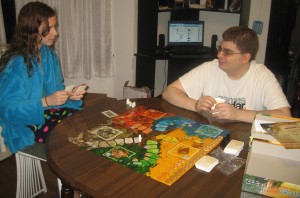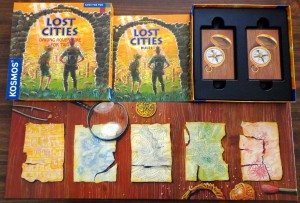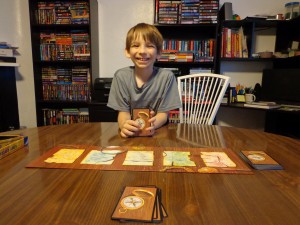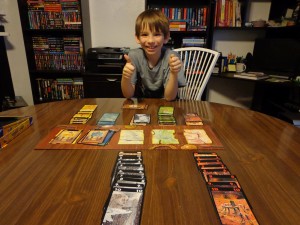My regular readers may have noticed that I already have a “Lost Cities” review up on my Board Games page. The Lost Cities card game is slightly different than the board game, but still warrants its own review. Let’s take a quick look at what makes this game similar to its sister game, as well as what makes it different.
Lost Cities (Board Game)
To sum up the board game version, players play cards of different colors in ascending numeric order so that they can move their figures along the five different colored paths. Each step along a path is assigned a point value and the early steps put the player into the negative. The steps along a path gradually build up to very high point values. Players will be attempting to move their figures along those paths as far as they can, picking up bonuses and artifacts along the way. This game as a whole can be played over one round or three, the artifacts adding up across all three rounds in the longer game. You can check out my review on this game by clicking on the following link: Lost Cities.
Lost Cities (Card Game)
The Lost Cities Card Game is a much quicker play experience when compared to the board game. It’s also only a two player game, so keep that in mind if you’re torn between purchasing either one game or the other. There is a four player variant listed in the manual, but it requires that players own an additional copy of this game. Owners of the board game will notice that there are no artifacts or bonuses to collect. Despite these differences, the goal is still the same…score more points than your opponent.
Editor’s Note: The game suggests the player age to be thirteen and over, but my eleven year old son had no issues playing it. Depending on the child, I’d say the minimum player age can be around nine or ten. Parents…you know your kids better than I do, so use your best judgement and feel free to ask questions!
Components
Board – In place of the main playing board (as seen in the board game), a smaller board is placed between both players that will help them keep track of the cards they are laying down to form expeditions. The spaces on the board itself are reserved for each color’s respective discard pile.
Cards – There are five different colored expedition cards, with values on them ranging from “2” through “10”. There are also three investment cards of each color, which players can play BEFORE starting an expedition to act as a score multiplier.
Setup & Gameplay
Players begin by deciding on how many rounds they’ll play, the scores of each adding up to decide who ultimately wins. Each player begins a round with eight cards and the board is placed between them.
On a player’s turn, they may:
1a) Add a card to an expedition – They may play one card from their hand to either start or add to an expedition on their side of the board. Expeditions must be played in ascending numeric order, however the numbers don’t have to be consecutive. A player can play up to three investment cards of the same color before that expedition begins, multiplying their final score of that expedition by two, three, or four, depending on how many investment cards are played.
OR
1b) Discard a card – They may discard a card from their hand and add it to one of the five discard piles on the board.
2) Draw a card – The player may draw one card from the deck or from one of the five discard piles on the table.
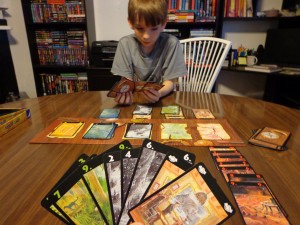
There is only one of each expedition card, so don’t start them unless you are sure you can break the initial twenty point cost.
Endgame and Scoring
The game ends when the draw pile runs out. Each expedition is scored individually, as follows:
1) If a player did not play a card (including investment cards) on any of the five potential expeditions, then those expeditions score nothing.
2) If a player played cards on an expedition, the score is equal to the sum of the numbered cards minus twenty (the initial cost of starting an expedition) multiplied by any multiplier (investment cards) that may be present, even if the result is a negative value. If a player played eight cards along one expedition, then that expedition scores a fixed bonus of twenty points (after the multiplier is factored in).
3) In the event a player played investment cards on an expedition but played no expedition cards, the score ends up being “-20” times the multiplier.
Players add up the points that their respective expeditions have earned them and compare totals. The round ends at that point and possibly the game, depending on how many rounds that players agreed to play. Whoever has the most points at the end of the final round wins the game!
The above is simply an overview of the rules and gameplay. If you’d like to learn more, you can check out the manual, located here:
The Review
First, I’d like to praise the quality of the components. They are beautiful to look at and very sturdy. The cards are huge and I had no trouble reading them, even across the table when glancing at my opponent’s expeditions. The manual does a good job in explaining all of the rules, and the game doesn’t take long at all to learn, especially if you’ve already played the board game.
The game is a mix of strategy and luck. It’s very possible that you’ll be drawing some really crappy cards from the draw pile, though the five discard piles help to alleviate this. The investment cards really add depth to the gameplay, forcing players to really think about how they want to tailor their hand and play their cards. Not only will the player be trying to score as many points as possible on the expeditions they’ve placed investment cards on, they’ll be trying to prevent their opponent from receiving the cards they need on the investment cards they’ve played. Sometimes a player will keep a useless card in their hand just so that the other player doesn’t snatch it up in the discard pile. Observing the other player’s expeditions becomes just as important as building on your own.
I’ve been asked a few times ever since I’ve written my Lost Cities review on which game is better…that is…the card game or the board game. Having finally owned the former, I still find myself at odds in chosing one over the other. The card game is a simpler, dumbed down version of the board game, however this does not necessarily make it inferior. Some (note the word “some”) casual gamers might find the board game to be “too much” and the card game “just right.” Jennifer enjoys playing the board game and she rarely takes a liking to anything in my collection. Even though I consider her a casual gamer, each person has different tastes and different preferences.
If you’re looking for a casual two player game that can be played quickly, without too many rules to think about, then the card game is a solid choice. If you have more time and more people involved and don’t mind the addition of a few more rules and components, then the board game would have a lot to offer. I personally utilize the card game when I want some one on one time with one of the kids or with Jennifer, and bring out the board game on family game night. Either way, both games are fun to play in their own right.
Final Verdict: 9/10
—

